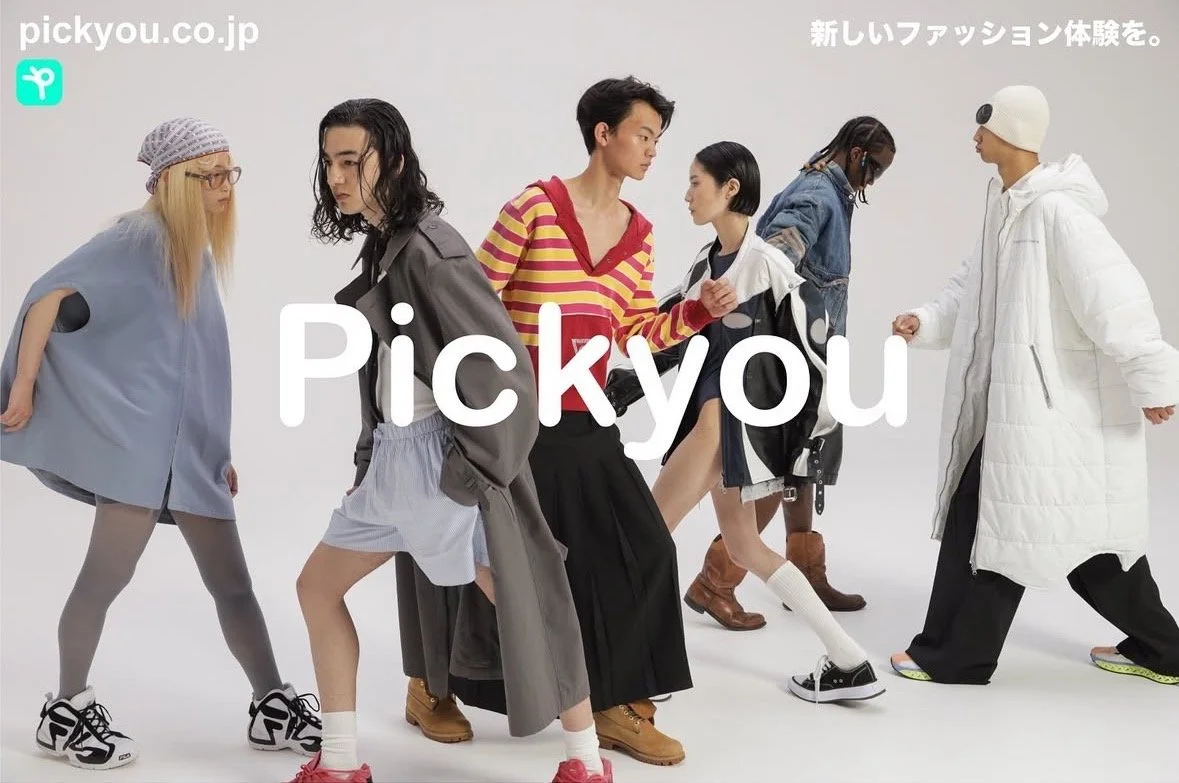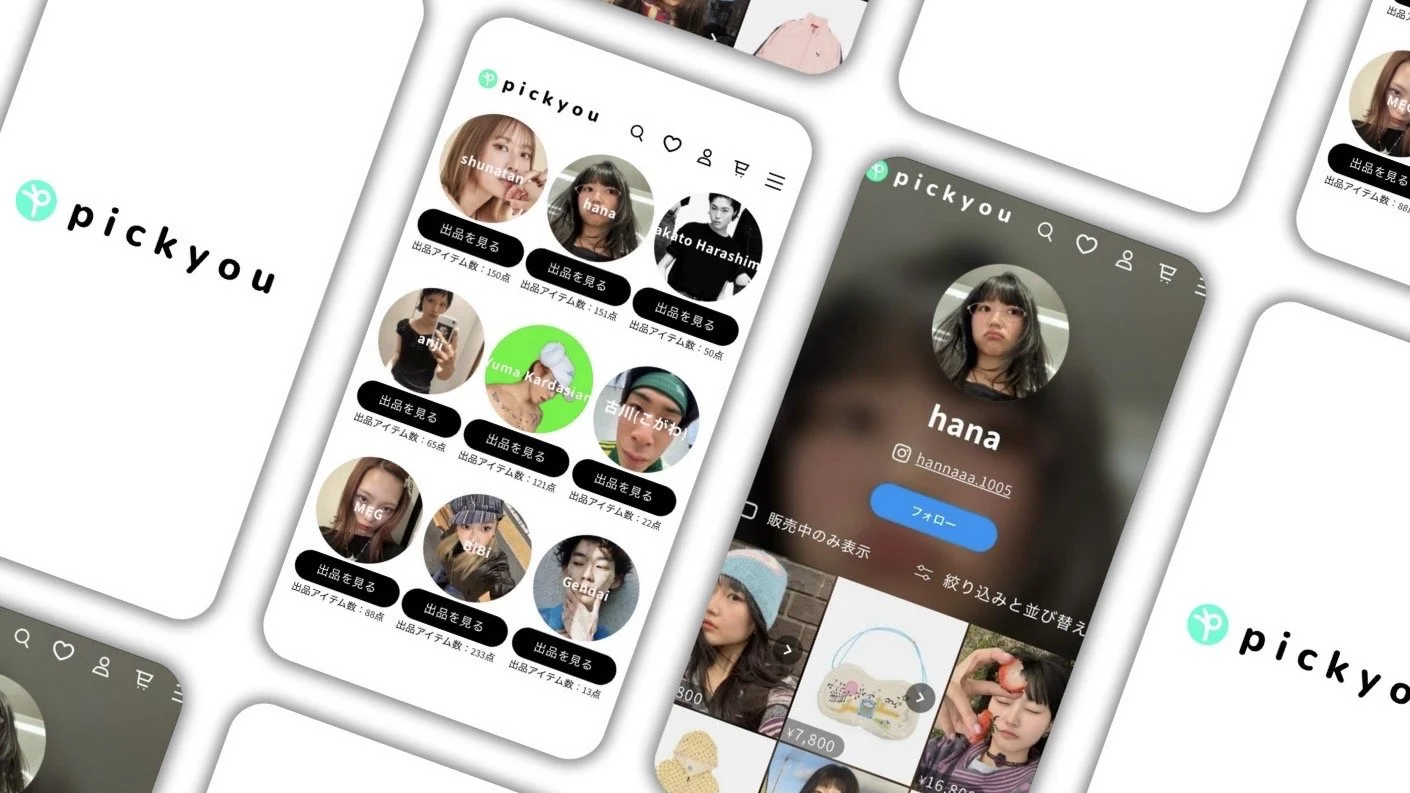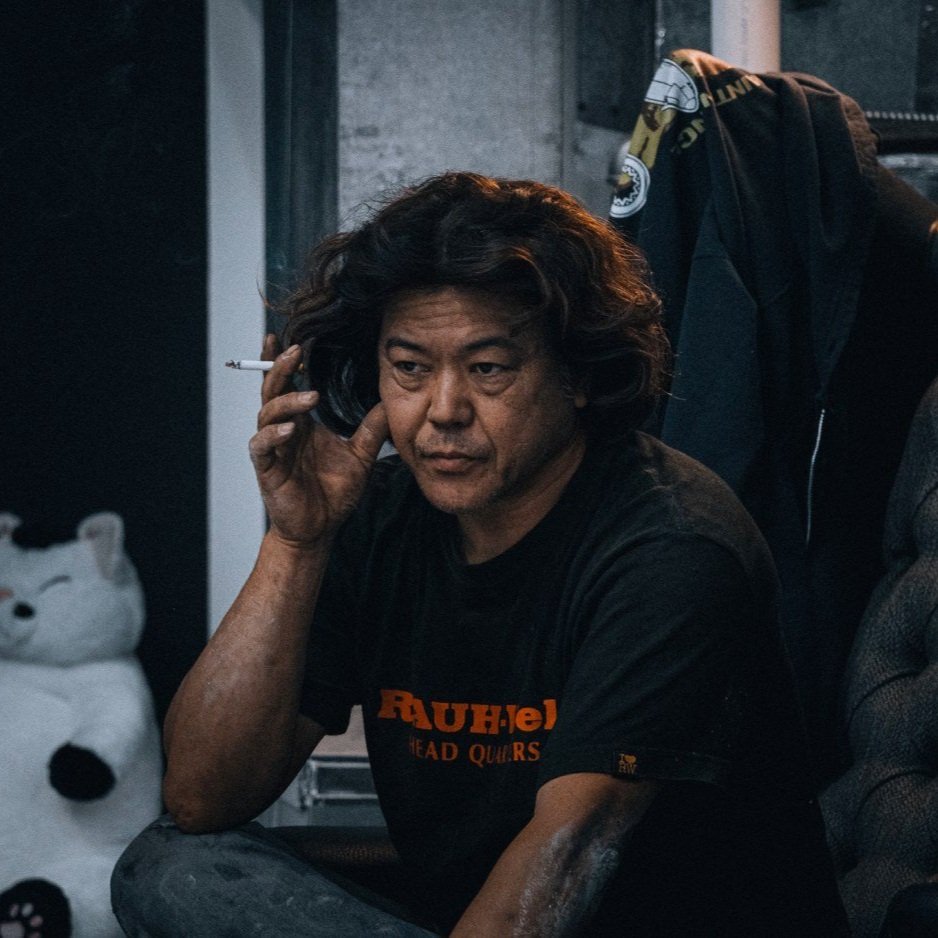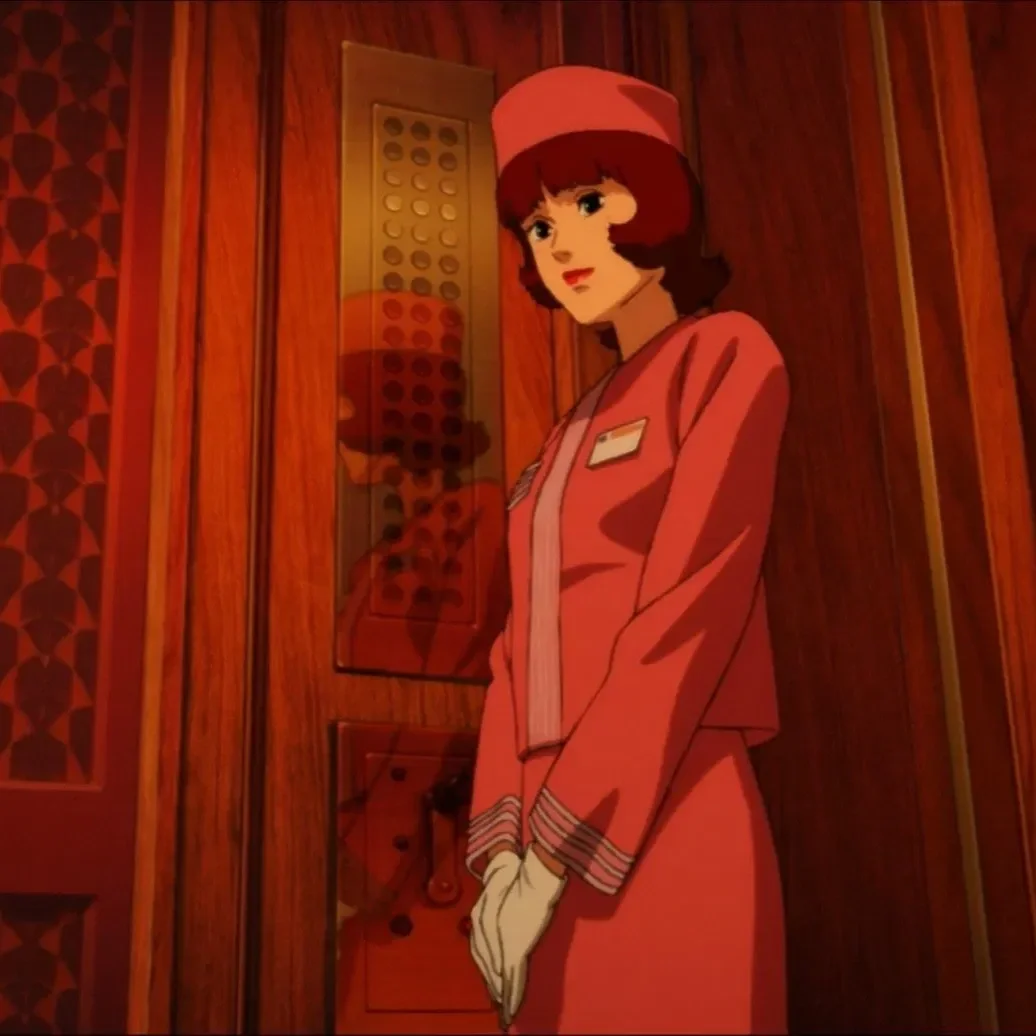How Pickyou Changed Tokyo’s Flea Market Scene
Two high school friends spun up a place where fashion lovers can buy second-hand pieces from stylish influencers.
Kota Kawai loves chairs. He also loves fashion, having studied pattern making at Bunka Fashion College in Tokyo. When he saw his room piling up with leftover fabrics from making clothes, it compelled him to use the scraps to make something. His chair installations were born.
Colorful collages and dispatches of discarded clothing creep along the surface of the chairs. Imagine a carpet of moss colonizing the tree bark. Only it’s the chairs that are cloaked in vibrant fabrics like puffer jackets, Adidas sports scarves, and knit sweaters.
“Through my experience with remaking clothes, I started to enjoy breaking the rules—like cutting into parts you’re not really supposed to, or taking a finished piece and turning it into something completely new. That idea of reshaping something existing really appealed to me. So I started thinking, what if I could apply fashion to a totally different format?”
Kawai, also the co-founder and creative director at Pickyou, jumps on late to our Google Meet call. He quickly dives into his former career as a "chair artist." The timing for his artist journey couldn’t be more perfect. It was right around when Japan was turning its attention to the SDGs and the “Fourth Art Boom,” as Kawai recalls, was in full swing. During this time when the arts were popping up everywhere, Kawai didn’t just want to make any patchwork chair.
“I wanted to add real context and value to it,” he said. “That’s when I started embedding these narratives into my work: like the idea that you can only truly rest when you’re mindful of the environment, or how even chairs—symbols of authority and status—are now overflowing with discarded clothes.”
Kawai’s friend and co-founder, Rio Tomita, 26, comes off as very normal, very friendly. In a simple grey hoodie and classic black framed glasses, he agrees: “It’s not like I have an exceptional personality or special skills or anything. I’m just average.”
One is a creative, the other a pragmatist. One can be a bit flaky, the other perfectly punctual. One is from friendly, fun-loving Osaka, and the other is from Kanagawa (a prefecture characterized by urbanized sophistication). Their contrast can feel stark.
The two met back in high school. Tomita was instinctively drawn to Kawai’s bold sense of style. He admired his friend’s unique aesthetic and, back then, would even wear Kawai’s hand-me-downs. Tomita got everything from a DIY chair, a white shirt, to a two-piece suit that Kawai made for his capstone project. In fact, this idea of “getting to wear something recommended or previously worn by someone you look up to is the idea that inspired the creation of Pickyou,” wrote FASHIONSNAP.com.
So how did these two distinct friends come together to launch Pickyou, one of the buzziest digital fashion flea market platforms in Japan today?
Launched in February of 2022, Pickyou works very much like the so-called digital marketplaces such as Depop, Vinted, and eBay. There are users who want to sell their clothes, and there’s a community of buyers who want to buy fashion at affordable prices. But with Pickyou, “our business is a flea market platform that sells used clothes and items actually worn by fashion icons,” Tomita describes. “Though only Japan-based sellers can list items currently, people overseas can still buy. International orders have been growing quite a bit lately, too. ”
Unlike Depop or others, Pickyou lets cutting-edge young creatives sell curated collections. The lineup includes names like Kyan (a Japanese-Australian content creator), model Mishima Hina (one of the three dreamy girls in the recent Petra Collins x Jenny Fax campaign), and Balenciaga model Takato Harashima, to name a few.
For those not familiar with the above names, think the NYC-based whimsical digital creator Kitty Lever, Chinese model and fashion influencer Tan Suan, or Ariel McKenna, the thrifting guru known as @b4rbrain on Instagram. Not all Pickyou sellers fall into the categories of content creators, models, fashion designers, or artists. But the strong curation, including some of the “iykyk” icons popular among fashion-forward Gen Zs in Japan, is what sets the platform apart from the others.
When Tomita graduated from college in 2021, the thought of joining the corporate grind wasn’t on his radar. He wasn’t bothered that peers around him got busy polishing their resumes, going to interviews, and attending company info sessions. Tomita's personality stands out in Japan, where most students engage in rigorous job-hunting, starting as early as a year before graduation.
“For one, I've never really been the type to worry about that stuff. And second, I already had this feeling even before we launched the service that if I did this with my co-founder, it would probably work out.”
Tomita intuitively looked to Kawai as his other founding force. He bet on Kawai’s creativity and sense of visuals, two qualities that Tomita saw himself lacking. “I also really admire his consistency—not getting thrown off or unmotivated—and the fact that he never says he can’t do something,” Tomita said. “He just quietly levels up, and new ideas keep coming to him.”
Kawai knows when to quit. When he saw that he was making a name for himself as a chair artist, Kawai decided to walk away and join Tomita for Pickyou’s launch. By then, he had already held a solo exhibition “Ethical Consumption Chair” in Tokyo and was awarded “The Mavericks of 2021” by Hearst Digital Japan as one of the SDGs pioneers. He had also collaborated with some notable domestic fashion brands, including ASICS, Tatras, Dairiku, and New Era’s “The Cap” line.
“As I was creating all these pieces, I started realizing that you can actually add value to something like a chair, beyond just what it is. By changing the way people experience it, you actually change its worth,” Kawai said. “People saw that, and it clicked—it’s possible to transform the outside value just by rethinking the inside.” This realization marked a turning point, leading him to step away from chair artworks. It was right around that perfect moment (again) when Tomita approached him with the idea of starting Pickyou together.
Pickyou first took off with its “What are you wearing today?” man-on-the-street-style Instagram Reels. It’s a short video where the Pickyou team asks cool, trendy youths in the streets of Tokyo to describe their OOTDs (“Outfit of the Day”). The people featured in these videos range from a Bathing Ape’s runway model to an anonymous hair stylist, who just happens to pull off a distinctive look.
In a way, Pickyou merges the fine line between micro-influencers and anonymous Tokyoites who just love fashion. It’s where cool kids with just 300 followers, stylish models who walked Paris Fashion Week, and content creators with 50K followers are all featured on the same platform, united by an eye for fashion.
Society’s longing for the nostalgic street snaps perhaps explains why Pickyou has gained traction so quickly. The platform has reached 300K followers (at least, as of May 2025) in about three years since its launch.
The fashion community has long favored street snaps. There’s i-D magazine’s The Straight-Up series, which documents the street-style scenes around the world from Accra to Taipei. And the legendary 1997 issue of FRUiTS magazine, which chronicled the fashion subculture styles of the Harajuku neighborhood of Tokyo, where cool kids with eclectic styles still congregate today.
Kawai also agrees that back in his school days, he was very much inspired by the old street snaps. The whole street snap culture pushes people to dress actively and go out. It gives people the hope that they perhaps might also get the chance to be photographed if they stepped up their style.
But FRUiTS folded in 2017, and i-D went into a hiatus in 2023, following the bankruptcy of its parent company, Vice. So did the street snap culture. Media like FASHIONSNAP.com and DROP TOKYO followed suit, which launched as a Tokyo street snap site in 2005 and 2007, respectively. But its static photos can’t beat the popularity of street snap videos, which, as Tomita says, “the whole 'What are you wearing today?' kind of content — we were actually the first ones to kick that off. And now, honestly, I feel like almost every fashion account is using that format."
Pickyou adapted well to the changing digital landscape by morphing the static street snap into video content. Since then, other fashion platforms have also started to adopt the same approach, releasing their own “What are you wearing today?” reels.
“At some point, people just get tired of it, right? Like, 'Yeah, I’ve seen this a million times.’ The idea is to drop it before it gets old. That’s something Kawai’s always said — switch things up while it’s still working. Don’t wait for it to get stale,” Tomita says. “To keep things fresh, sometimes you've got to know when to quit. Quitting isn’t failure; it’s just making space for the next idea."
Tomita isn’t afraid that Pickyou will be consumed as some fleeting fashion platform of the moment. He believes in Kawai’s creativity to constantly come up with new ideas, and so does Kawai himself. Currently, they’ve shifted to a new Reel format called “STOP OUTFIT,” where Kawai approaches the stylish individuals and “casts” a time freeze spell, stopping them in mid-motion on the streets. The video then goes around the frozen being and inspects their clothing details and overall styling in close-up shots.
More recently, Pickyou has also launched a physical store. Tucked in the quiet corner of 2 Chome Meguro City in Tokyo, EST-Frames is Pickyou’s physical retail store that opens only on the weekends. From the sleek, minimalistic building exterior, one would never guess that heavy techno music permeates its third-floor space, where EST-Frames is located.
The store concept is almost like a fusion of a flea market and a high-end boutique: there’s no cohesion in the vintage pieces that are being sold, but everything is displayed neatly like a designer fashion retail store.
“That randomness is what makes the space so unique. There’s like this weird glitch in the whole idea of what pricing should be, too,” Kawai says. Each seller gets to set their own pricing.
It’s been a milestone moment. Kawai looks back with love at the fashion friends and supporters who had his and Tomita’s backs from the beginning. Their presence was also key in making Pickyou feel like a legit fashion-forward platform from day one.
“For me, having cool people back your project is the strongest form of trust. A big part of that is the fact that the people I’ve worked with and built relationships with over time (when working as the chair artist) have always been genuinely cool,” Kawai said. “So when I started this, I reached out to those people.”
And whose closet would the duo want to raid?
For Tomita, it’s Takeru Urushibara—a London-based hair and makeup artist known for putting out clean-fit pieces in shades of grey, black, and icy green on Pickyou.
Kawai shouts out to his friends. There’s IORI Yamaki of DINOWORKS, whose Pickyou profile features rare gems like a bold blue Adidas x Jeremy Scott jumpsuit covered in white stars. And then there’s N00b, a Japanese-Chinese designer who sells avant-garde pieces imbued with military-inspired ruggedness on the platform.
In a way, the line of pieces curated on Pickyou best candidly captures how cutting-edge Gen Zs in Japan dress today. Tokyo style has always been about mixture, blending everything from high-end, vintage, luxury, and brands from both international and domestic. Browsing through the wide range of items available on this digital secondhand site, Pickyou encapsulates this style ethos.
“You’ll find pieces that fit all kinds of different styles, not just one look,” Kawai said. “It's definitely something you don’t see in other shops. It feels like we’re building the next generation of fashion culture.”










Tokyo’s outsider spirit, Blue Spring, and emotion stitched into Elsewhere.